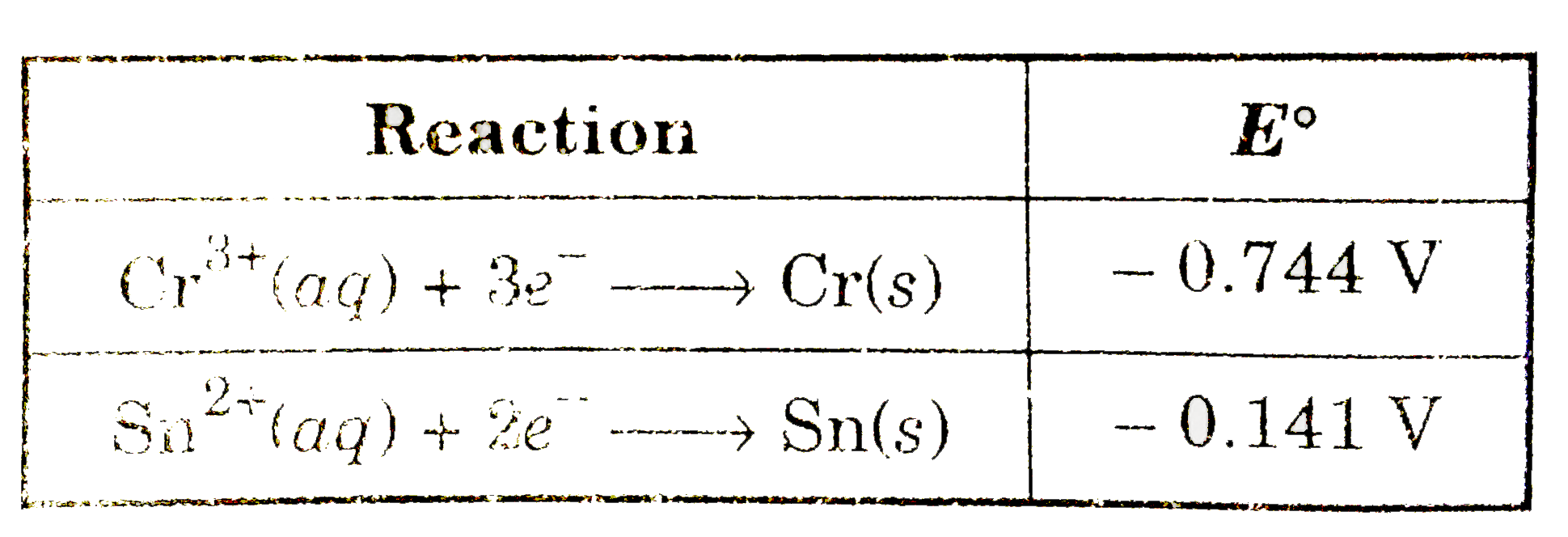Given that the standard reduction potential (E∘) of Cr3+∣Cr and Cr2+∣Cr are -0.74 and -0.91 V respectively. The E∘ of Cr3+∣Cr2+ is:
−0.83V
+0.4V
−0.4V
−0.18V
The correct Answer is:C
Cr3++3e−→CrΔ∘G1=−3×F(−0.4)
Cr→Cr2++2e−Δ∘G2=−2×F×0.91
¯¯¯¯¯¯¯¯¯¯¯¯¯¯¯¯¯¯¯¯¯¯¯¯¯¯¯¯¯¯¯¯¯¯¯¯¯¯¯¯¯¯¯¯¯¯¯¯¯¯¯¯¯¯¯¯¯¯¯¯¯¯¯¯¯¯¯¯¯¯¯¯¯¯¯Cr3++e−→Cr2+Δ∘G3=Δ∘G1+Δ∘G2
Δ∘G3=Δ∘G1=Δ∘G2
−nE∘3F=2.22F+(−1.82F),E∘3=−0.4V
Similar Questions
Determine the potential for the cell :
Pt∣∣Fe2,Fe3+∣∣∣∣Cr2O2−7,Cr3+,H+∣∣Pt
in which [Fe2+] and [Fe3+] are 0.5 M and 0.75 M respectively and [Cr2O2−7],[Cr3+] and [H+] are 2M, 4 M and 1M respectively. Given :
Fe3++e−→Fe2+E∘=0.770volt14H++6e−+Cr2O2−7→2Cr3++7H2OE∘=1.35 volt
View SolutionCalculate the electrode potential at 25∘C of Cr3+,Cr2O2−7 electrode at pOH=11 in solution of 0.01 M both in Cr3+ and Cr2O2−7
Cr2O2−7+14H++6e→2Cr3++7H2O
E0=1.33V.
View Solution
Knowledge Check
Ec− for Cr3++3e−→Crand Cr3++e−→Cr2+ are −0.74V and −0.40V, respectively, Ec− for the reaction is Cr+2+2e−→Cr
A−0.91VB+0.91VC−1.14VD+0.34VCalculate Ecell for Cr∣∣Cr3+∣∣∣∣Cr3+∣∣Cr:
A(0.028V)B(0.083)C(0V)D(0.125)What is the standard cell potential for the reaction,
2Cr(s)+3Sn2+(aq)→3Sn(s)+2Cr3+(aq)
given the E∘ values shown?
 A0.945VB0.603VC−0.603VD−0.945V
A0.945VB0.603VC−0.603VD−0.945V
Given the standard electrode potentials,
K+/K=−2.93V,Ag+/Ag=0.80V,
Hg2+/Hg=0.79V
Mg2+/Mg=−2.37V,Cr3+/Cr=−0.74V
Arrange these metals in their increasing order of reducing power.
View SolutionSn4+(aq)+2e−→Sn2+(aq) E∘=0.15V
Cr3+(aq)+e−→Cr2+(aq) E∘=0.41V
According to the standard reduction potentials above, what is the value of E∘ for the reaction below?
2Cr3+(aq)+Sn2+(aq)→2Cr2+(aq)+Sn4+(aq)
View SolutionThe standard reduction potential data at 25∘C is given below
E∘(Fe3+,Fe2+)=+0.77V,
E∘(Fe2+,Fe)=−0.44V,
E∘(Cu2+,Cu)=+0.34V,
E∘(Cu+,Cu)=+0.52V,
E∘(O2(g)+4H++4e−→2H2O]=+1.23V
E∘[(O2(g)+2H2O+4e−→4OH−)]=+0.40V,
E∘(Cr3+,Cr)=−0.74V,
E∘(Cr2+,Cr)=−0.91V,
Match E∘ of the redox pair in List-I with the values given in List-II and select the correct answer using the code given below teh lists:
List−IList−II(P)E∘(Fe3+,Fe)(1)−0.18V(Q)E∘(4H2O⇔4H++4OH+)(2)−0.4V(R)E∘(Cu2++Cu→2Cu+)(3)−0.04V(S)E∘(Cr3+,Cr2+)(4)−0.83V
Codes:
View SolutionCopper from copper sulphate solution can be displacesd by. (The standard reduction potentials of some electrodes are given below):
Eo(Fe2+/Fe)=−0.44V,Eo(Zn2+/Zn)=−0.76V
Eo(Cu2+/Cu)=+0.34V:Eo(Cr3+/Cr)=−0.74V
Eo(H+0H2)=0.00V
View SolutionWhat will be standard cell potential of galvanic cell with the following reaction?
2Cr(s)+3Cd2+(aq)→2Cr3+(aq)+3Cd(s)
[Given: E∘Cr3+/Cr=−0.74V and E∘Cd2+/Cd=−0.4V
View Solution
